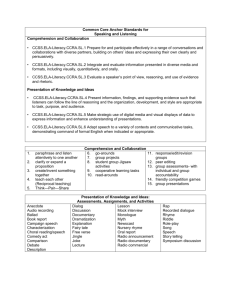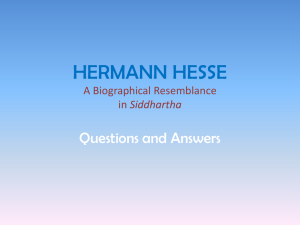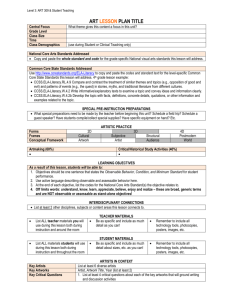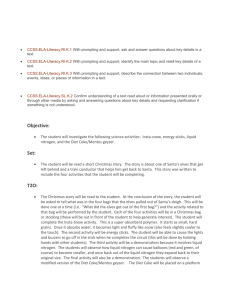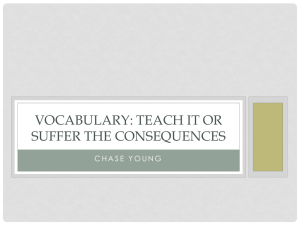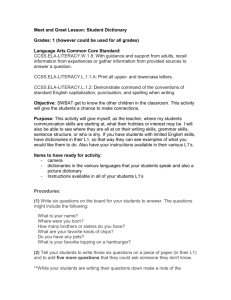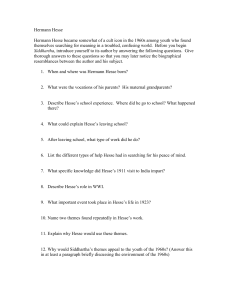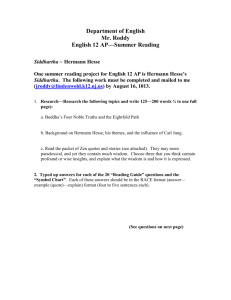File
advertisement
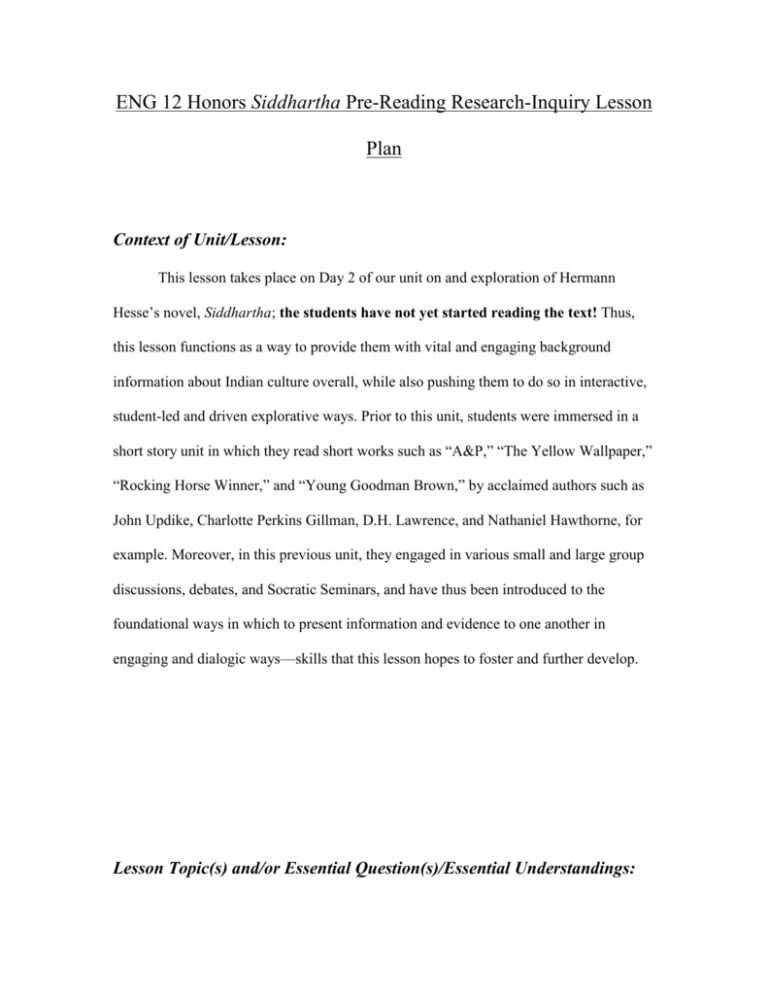
ENG 12 Honors Siddhartha Pre-Reading Research-Inquiry Lesson Plan Context of Unit/Lesson: This lesson takes place on Day 2 of our unit on and exploration of Hermann Hesse’s novel, Siddhartha; the students have not yet started reading the text! Thus, this lesson functions as a way to provide them with vital and engaging background information about Indian culture overall, while also pushing them to do so in interactive, student-led and driven explorative ways. Prior to this unit, students were immersed in a short story unit in which they read short works such as “A&P,” “The Yellow Wallpaper,” “Rocking Horse Winner,” and “Young Goodman Brown,” by acclaimed authors such as John Updike, Charlotte Perkins Gillman, D.H. Lawrence, and Nathaniel Hawthorne, for example. Moreover, in this previous unit, they engaged in various small and large group discussions, debates, and Socratic Seminars, and have thus been introduced to the foundational ways in which to present information and evidence to one another in engaging and dialogic ways—skills that this lesson hopes to foster and further develop. Lesson Topic(s) and/or Essential Question(s)/Essential Understandings: Course: English 12 Honors Topic: Pre-Reading Research/Multimodal Presentations in Correspondence with Hermann Hesse’s novel, Siddhartha. Essential Question: How can we further develop leadership and interrelationship skills? How can we delve deeper into understanding various cultures and expand our worldly knowledge about Indian culture more specifically? How can this knowledge build a foundation for a deeper understanding of (and appreciation for) Hermann Hesse’s novel, Siddhartha? Essential Understandings: This lesson encourages students to expand upon their knowledge of another culture and way of life and engages students in teamwork skills as they conduct research surrounding specific topics that will lend themselves to a deeper and more thorough understanding of Indian culture as it is portrayed in Hermann Hesse’s novel, Siddhartha. It also aims to inform students about a wide variety of topics, while also shifting away from a more “traditional” teacher-based lecture-style presentation of essential background information. In this way, this lesson also pushes students to further develop their leadership and communication skills as they work together and present research-based information to their peers in multimodal, more engaging ways. Objectives: SWBAT explore and synthesize aspects of Indian culture through research-based, small-group inquiry. SWBAT communicate effectively within their small-groups and elaborate upon one another’s ideas in small-group discussions. SWBAT present their research-based inquiries in engaging ways through the use of multimodal technology. Standards: CCSS.ELA-LITERACY.RI.11-12.7: Integrate and evaluate multiple sources of information presented in different media or formats (e.g., visually, quantitatively) as well as in words in order to address a question or solve a problem. CCSS.ELA-LITERACY.SL.11-12.1: Initiate and participate effectively in a range of collaborative discussions (one-on-one, in groups, and teacher-led) with diverse partners on grades 11-12 topics, texts, and issues, building on others' ideas and expressing their own clearly and persuasively. CCSS.ELA-LITERACY.SL.11-12.1.A: Come to discussions prepared, having read and researched material under study; explicitly draw on that preparation by referring to evidence from texts and other research on the topic or issue to stimulate a thoughtful, well-reasoned exchange of ideas. CCSS.ELA-LITERACY.SL.11-12.1.B Work with peers to promote civil, democratic discussions and decision-making, set clear goals and deadlines, and establish individual roles as needed. CCSS.ELA-LITERACY.SL.11-12.2: Integrate multiple sources of information presented in diverse formats and media (e.g., visually, quantitatively, orally) in order to make informed decisions and solve problems, evaluating the credibility and accuracy of each source and noting any discrepancies among the data. CCSS.ELA-LITERACY.SL.11-12.4: Present information, findings, and supporting evidence, conveying a clear and distinct perspective, such that listeners can follow the line of reasoning, alternative or opposing perspectives are addressed, and the organization, development, substance, and style are appropriate to purpose, audience, and a range of formal and informal tasks. CCSS.ELA-LITERACY.SL.11-12.5: Make strategic use of digital media (e.g., textual, graphical, audio, visual, and interactive elements) in presentations to enhance understanding of findings, reasoning, and evidence and to add interest. Instructional Materials and Resources: Class Set of iPads (to be used for small-group research purposes) Technological Modality (students will have a choice of the particular technological modality their groups would prefer to use; for example, PowerPoint, Prezi, Pinterest, a poster board, a performance, etc.) Rationale: I fervently value and see huge pedagogical benefits in research-based inquiry prereading activities/small projects, particularly when diving into a text that introduces a vastly different cultural lens than that of what students are surrounded by in their everyday lives, and in their own immediate community, as is the case with Hermann Hesse’s novel, Siddhartha. That is to say, I firmly believe that allowing students to explore topics related to a text prior to even opening a page—especially one as far removed from students’ own lives as Siddhartha—encourages them to better connect with the text from the very start—therefore hooking them from the onset, and paving the way to greater understandings of the text as a whole. Thus, this lesson engages students in exploring subject matter that is culturally relevant, thought provoking, and eye opening and that directly relates to and provides further insights about Indian culture, as it is represented within German author Hermann Hesse’s reflective, fictional memoir, Siddhartha. Moreover, the very title of this course—English 12 Honors: Leadership and Interrelationships—is ultimately the foundation of this lesson, and has largely driven the structure of this research-based inquiry activity as a whole. More specifically, this lesson strives to incorporate these course goals and invaluable life skills by encouraging students to work amongst their peers as they further develop their leadership and interrelationship skills as they discuss the knowledge that they have acquired through previous research and work together to create an engaging presentations that they will then be required to showcase to their classmates as they inform one another of essential aspects of their findings. Furthermore, by the same token, this lesson also works to push the boundaries of a “traditional” ELA classroom in that it moves away from “typical,” and oftentimes rather dry teacher-led lecture-style presentations about fundamental background information that will lead to a deeper understanding of a given text; it instead places students in a leadership position (one of the main goals of the ENG 12H curriculum) while also granting them the autonomy to share aspects of their particular topic that they find particularly engaging and essential to their peers’ understanding of a specific subject matter. In this way, this lesson also acts as a scaffold to future lessons within this particular unit and throughout the course as a whole, as it allows students to further develop their abilities to synthesize and analyze research, informational, and even literary texts as well as discuss and present their evidence to their peers. Instructional Tasks and Activities: ESSENTIAL NOTE: The day prior to this lesson (Day 1 of the unit), students signed up for groups (the groups were student-chosen but limited to a maximum of 6 students) and one group “leader” randomly selected a group topic. Then, they spent approximately 25 minutes working independently in researching and taking notes on their particular assigned topics in order to think deeply about the subject matter they were researching before jumping into a potentially distracting and inhibiting group setting. This was done intentionally in order to assure that students would have a foundation of research to utilize the following day when they began working with their group members. What the Instructor Will Be Doing: What the Students Will Be Doing: 2-3 minutes: Explaining “rules of the road”: giving/clarifying directions and expectations for research-inquiry group presentations. 2-3 minutes: Listening as Ms. K gives instructions. 20-25 minutes: Circulating amongst groups to make sure that students are on task and are working productively in 1.) sharing ideas/the research they conducted the day prior 2.)creating an engaging presentation through their chosen modality. 20-25 minutes: Working with group members as they share information surrounding the research they independently conducted the day prior as well as creating an engaging presentation through their chosen modality. 2-3 minutes: Explaining the “rules of the road” for group presentations. 2-3 minutes: Listening as Ms. K the “rules of the road” for group presentations. 20-25 minutes: Listening and taking notes (evaluating) as group members present, asking clarifying/further questions as needed/is necessary following group presentations. 20-25 minutes: Listening and taking notes (using provided handout) as group members present, asking clarifying/further questions following group presentations Student Assessment: Students will be assessed in the following ways, and based on the following criteria: -As students work, both my mentor teacher (Mrs. Lounds) and I will be circulating amongst groups in order to not only be certain that our students are on task, but in order to take note of the ways in which they work together in a group setting, particularly as one of the main course goals/criteria is fostering and further developing student interrelationships/leadership skills. -As students are presenting, I will also be taking notes on their presentation style in order to evaluate the ways in which they not only generate ideas, but ultimately showcase them in engaging ways. -Thus, students will receive two separate grades: one based on their group work, and the other on the ways in which they present their material/subject matter. -I then plan to provide general group and individual feedback to my students (brief conference style, on Monday and throughout the week next week—the individual feedback will be done privately) with the ultimate goal of further developing students’ leadership and interrelationship skills by pointing to students’ strengths in small-group and presentation settings, as well as areas for improvement.

